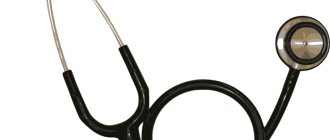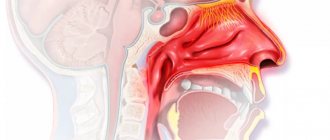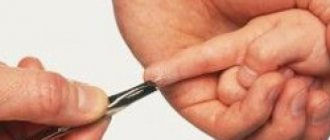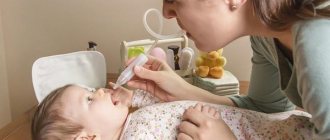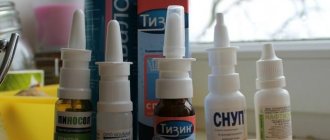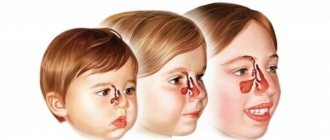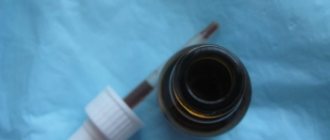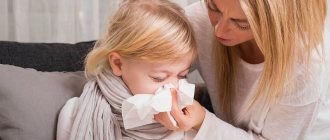In medicine, a runny nose has a slightly different name - rhinitis - and is an inflammatory process of the nasal mucosa. This disease can appear on its own, or it can be a resulting symptom of ARVI, influenza and other infectious diseases. The causative agents here are bacteria (virus, streptococcus). Rhinitis develops with hypothermia, decreased immunity and has several stages.
Initially, the mucous membrane swells, becomes red and dries out. There is a feeling of heaviness in breathing through the nasal passages. Later, the swelling subsides a little, and a strong discharge of transparent secretion appears (rhinorrhea). In this case, dryness and difficulty in breathing disappears.
If you ignore the first stage of a runny nose, this can provoke the appearance of purulent accumulations. With the correct response to the disease, it declines, and then complete recovery occurs.
There are many fairly simple ways to get rid of a runny nose, including traditional methods. Some relieve the disease in three days, others help alleviate the general condition of the body and eliminate nasal congestion.
General information about baby runny nose
Experts identify several variants of a runny nose that are possible in both adults and children. They arise for various reasons:
- Due to infections usually affecting the upper respiratory tract, including the ARVI group and influenza.
- Due to allergic diseases, in which a runny nose is one of the symptoms of hay fever (pollen allergy) or a reaction to wool, mold, food, medications.
- As a result of abnormal reactions of blood vessels in the nasal mucosa when exposed to irritants - strong odors, cold or dry air (such a runny nose is called vasomotor rhinitis).
Knowing the cause is especially important for treating runny nose in children.
The choice of means that can eliminate nasal congestion, difficulty breathing, and reduce the secretion of thin or thick mucus depends on it. If some drugs are used for almost all types of runny nose, then others - antibiotics, hormonal sprays - will be indicated only for some of its variants and only a doctor can prescribe them, especially to a child. ARVI is the most common cause of children's runny noses, along with cough, fever and general malaise. During the cold season, viruses actively spread in crowded places - in children's clinics, at school or in a kindergarten group. One sick child is enough for his coughing, screaming or sneezing to spread hundreds and even thousands of viruses into the air, which enter the body of healthy children with droplets of mucus. Viruses settle on surfaces, toys, get on your hands, and from there into your nose and mouth.
Adults can also infect a baby; they are more likely to be in crowded places, from where they can bring viruses. Therefore, even a child who does not regularly visit shopping centers, cafes and cinemas can get sick. So, alas, infection could not be avoided. How to treat a runny nose in a child?
Symptoms
With any type of rhinitis, changes occur in the mucous membrane of the upper respiratory tract. This manifests itself in the following symptoms:
- difficulty breathing;
- narrowing of the nasal passages caused by swelling;
- unusual sensations in the nose: burning, itching, tingling;
- tearfulness of the eyes;
- headache;
- redness of the nose and upper lip;
- formation of nasal mucus.
Symptoms of rhinitis in children
If the baby’s rhinitis has become chronic, the symptoms are less severe. The child constantly has a stuffy nose, the amount of nasal discharge either increases or decreases. The nature of the mucus may change from more abundant and watery discharge to thicker, purulent discharge.
Method 1. Treatment of a runny nose with vasoconstrictors
Having noticed the first signs of a cold with rhinitis in a child, as a rule, parents rush to the pharmacy to purchase drugs that will provide quick and effective treatment for a runny nose.
In children, the use of such products should primarily perform two functions - relieve nasal congestion and reduce mucus discharge from it. For these purposes, vasoconstrictor drugs are used in various forms. These can be drops or sprays for runny noses for children. Such drugs narrow the small vessels in the nose, which reduces swelling of the mucous membranes and makes breathing easier. However, they only reduce the severity of unpleasant symptoms. And the effect of their use can last from 4 to 12 hours, then repeated instillation is necessary. Although some of these drugs are approved for use even in babies under one year old, they should be used in childhood with extreme caution.
Doctors who know how to properly treat a runny nose in children recommend using such remedies for no more than 3-4 days. Otherwise, addiction is possible, in which the child’s nose simply cannot breathe without drops. In addition, thoughtless use of vasoconstrictor drugs can lead to irritation and drying of the nasal mucosa. Therefore, they are usually combined with delayed-action drugs, the effect of which occurs after a few days, when the use of vasoconstrictor sprays or drops becomes undesirable and requires discontinuation.
Herbal ointments
Ointments have a healing effect on the nasal cavity for a long time. Balm “Zvezdochka” is considered the most powerful and effective remedy for nasal congestion.
Among homemade ointments you can use onions, Kalanchoe, and cyclamen. However, to obtain the consistency of the ointment, you need to add honey or Vishnevsky ointment to the crushed pulp.
As an example, take 1 tsp. All of the listed components are mixed to obtain a homogeneous mass. The resulting ointment should be lubricated into the nasal passages and repeated several times a day.
Method 2. To start using hormonal medications, it is important to know the causes of a runny nose!
The next group of drugs that we will consider are hormonal drugs for the treatment of runny nose in children.
They are used when an allergy is diagnosed or drug-induced rhinitis (dependence on vasoconstrictors) has developed. In addition, these drugs are indicated for chronic runny nose, treatment of severe rhinitis with complications in the form of sinusitis (inflammation of the paranasal sinuses). A doctor may recommend hormonal drops for a runny nose; sprays or ointments are also suitable for children. The effect occurs gradually, lasting relief is usually achieved after 2-3 weeks of use. Treatment of allergic rhinitis in a child with the help of hormonal drugs is indicated only for severe, pronounced forms.
These drugs do not damage the mucous membrane and are not addictive, but they have a fairly extensive list of contraindications and side effects. Therefore, they are used only as prescribed by a doctor.
Diagnostics
A pediatrician, otolaryngologist, or allergist can diagnose your child. Tests and examinations that may be required to diagnose rhinitis:
- general examination of the child;
- anterior rhinoscopy (examination of the nasal cavity using a special dilator);
- laboratory examination of a nasal swab.
If rhinitis occurs as a symptom of an infectious disease (measles, influenza, whooping cough), additional diagnostic methods may be required. If you suspect an allergic nature of rhinitis, the doctor will suggest conducting a specific examination (skin tests, provocative tests).
Video - How to treat a runny nose
Method 4. Rinsing the nose with sea water: we treat congestion and runny nose comprehensively
One of the most harmless ways to combat a runny nose is to rinse your nose.
When a child has a runny nose, sea water or saline solution is injected into the nasal sinuses. They thin out thick mucus and remove it, wash away viruses and germs from the surface of the mucous membranes, and gradually reduce swelling and inflammation. Both using sea water and rinsing the nose with saline solution for a runny nose helps children breathe easier, but the effect of the procedure is unstable and does not last long. In addition, washing will be truly safe only if carried out according to all the rules. Otherwise, the solution from the nasopharynx may enter the mouth of the auditory tube, which connects the nose to the middle ear, and there is a risk of developing otitis media. The procedure also has practical disadvantages - children do not really like it, and it is simply impossible to carry out rinsing in a kindergarten or school.
Rinsing with saline solutions or sea water should not be used as a separate means of treating a runny nose, but as part of a set of measures that should help the child breathe freely.
What is rhinitis?
“Runny nose” is the common name for rhinitis, an inflammatory process in the nasal mucosa. The main symptom of this disease is the intense formation of muconasal secretion (nasal mucus). The mucus itself does not pose a health hazard. It performs a protective function, moisturizes the inhaled air, traps dust particles, and has antiseptic properties.
With a viral or infectious disease, the amount of mucus secreted increases significantly. The body intensively produces muconasal secretions to neutralize microorganisms that disrupt the functioning of the nasopharynx. As a result, the patient suffers from profuse mucus discharge from the nose.
Important ! In childhood, infection from the nose often penetrates the respiratory organs, auditory tube, and paranasal sinuses. Rhinitis is especially dangerous for infants.
What is rhinitis
Method 6: Herbal medicine - how medicinal plants are used in medicine
Another group of drugs that can be prescribed to cure a runny nose in a child are herbal remedies, that is, products based on medicinal plants.
Such products are available in tablet form. They are especially effective when you need to relieve swelling and reduce sinus discharge. Typically, a phytotherapeutic remedy for a runny nose is prescribed for thick and viscous mucus that “clogs” the nose. But you shouldn’t expect instant results from herbal medicines. Their components begin to act a few days after the start of administration. But they reduce the risk of complications and can be used in combination with fast-acting medications for rhinitis. The disadvantage of herbal medicines is the possibility of allergies to plant components, as well as undesirable reactions from the gastrointestinal tract. That is why herbal medicine in the complex treatment of the common cold is usually prescribed to children 6 years of age and older.
Onion based treatment
Treatment with an onion is rightfully considered the most popular way to get rid of a runny nose. Onion compresses help the most.
To prepare them, you will need 1 onion, a napkin, water (to wet the napkin), and a small warm towel.
The onion needs to be grated, wrapped in a moistened napkin, and then applied to both wings of the nose. Cover the top with a warm, dry towel. Lie with this compress for about 15 minutes. For a quick recovery, the procedure should be repeated up to four times a day.
Treatment of a runny nose with folk remedies
Unfortunately, some parents prefer folk remedies for the runny nose to doctors’ recommendations. For children, in their opinion, they will be healthier and safer. Is it so? Many so-called “folk recipes for the common cold” were used at a time when official medicine was simply inaccessible to the general public - spells, chicken eggs, plant juices. Today it has been proven that “grandmother’s recipes” can not only be useless, but also cause serious harm to the child’s health. Possible irritation or damage to the mucous membrane, increased inflammation, its transition to the sinuses, and increased temperature. Therefore, parents who prefer natural treatment for colds and runny nose should choose nasal rinsing in combination with the use of essential oils and herbal medicine. THIS IS NOT AN ADVERTISING. THE MATERIAL WAS PREPARED WITH THE PARTICIPATION OF EXPERTS.
Conditions for recovery
It is not difficult to cure a runny nose if you approach this issue correctly. So, you need to provide the right conditions for recovery, try to minimize the use of medications and use herbal infusions, rinses, and the like.
Favorable conditions for a speedy recovery are:
- cool air temperature from 20 to 22 degrees;
- air humidity should vary from 50 to 70 percent;
- mandatory drinking in large quantities;
- Ventilate the room regularly.
If you fulfill at least a few of the listed conditions, then very soon your breathing will clear and return to normal.
Traditional methods of treatment that are the most effective include:
- nasal rinsing;
- inhalation;
- herbal ointments;
- onion-based treatment;
- regular foot steaming;
- treatment based on aloe juice.
Each method must be considered separately.
